Propensity models are a group of statistical models that provide immense value to your organization.
Read MoreGartner found that only 44% of data and analytics leaders believe their teams add real value. This often stems from analytics team delivering mountains of dashboards to business owners without any practical use. If you’re drowning in dashboards that merely recap yesterday, predictive analytics is the lifeline that turns hindsight into foresight.
Consider these three marketing black holes that doom most DTC owners: paying ever-higher CAC (brands report CAC up 60%+ since 2020), watching customers churn (DTC brands often churn 73% of customers) after only a couple of purchases, and guessing at lifetime value in the dark (41% of brands admit they can’t calculate it). Predictive analytics stops the CAC bleed by prioritizing ad spend on your top-tier prospects, surfaces churn signals 30–45 days before customers bail so you can intervene, and scores customer cohorts for true LTV—boosting loyalty program returns.
The intention of this article is to serve as a comprehensive primer that will teach you in simple terms what predictive analytics is, where it can be used in your business, the steps involved in implementing predictive models, future trends and answer common questions you probably have.
At its core, predictive analytics is the process of using past and present data to make educated guesses about the future. For example, an ecommerce owner might use predictive analytics to estimate next month’s sales, while another could use it to identify which customers are most likely to purchase another product.
Predictive analytics is the backbone of high-performance direct-to-consumer (DTC) marketing. By harnessing data to forecast customer behavior, brands can slash costs, boost profit, and lock in long-term loyalty. Below, we explore five quick hit critical business scenarios where predictive models solve common business questions. The what to expect answers are based on past experience and research.
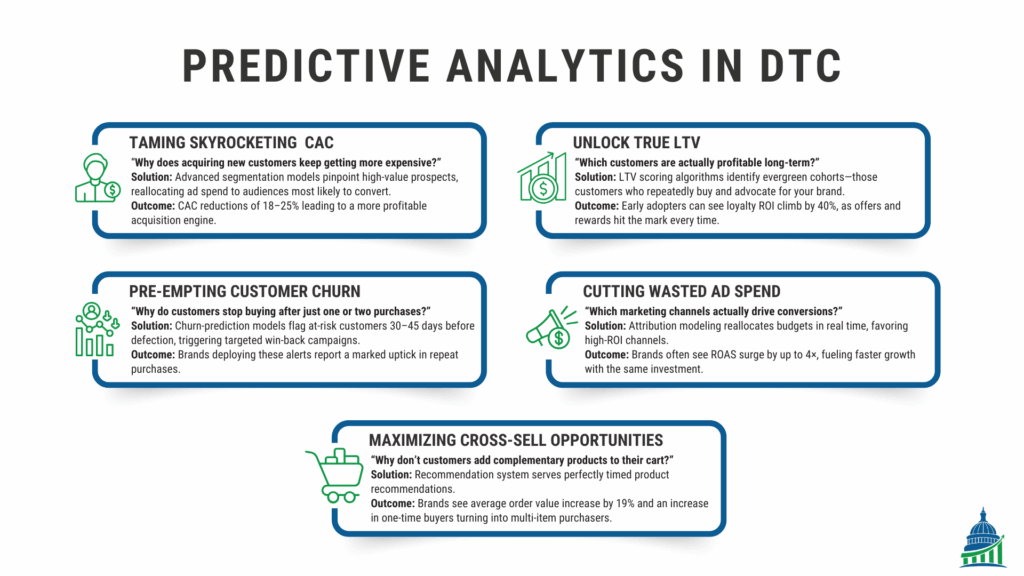
Taming Skyrocketing Customer Acquisition Costs (CAC)
Unlocking True Customer Lifetime Value (LTV)
Pre-Empting Customer Churn
Cutting Wasted Ad Spend
Maximizing Cross-Sell Opportunities
As these five scenarios highlight, predictive analytics transforms DTC owners from reacting to reporting into proactively driving profit. The next section shows you core components that make up the predictive modeling process and why you might need some help implementing it.
Even though predictive analytics can tackle myriad challenges—from reducing CAC to pre-empting churn—you can’t pursue every opportunity at once. Limited budgets, tight timelines, and scarce data-science resources mean you must ruthlessly prioritize. Here’s how to apply the ICE framework (Impact, Confidence, Ease) and a 20%-return threshold to zero in on the highest-ROI projects.
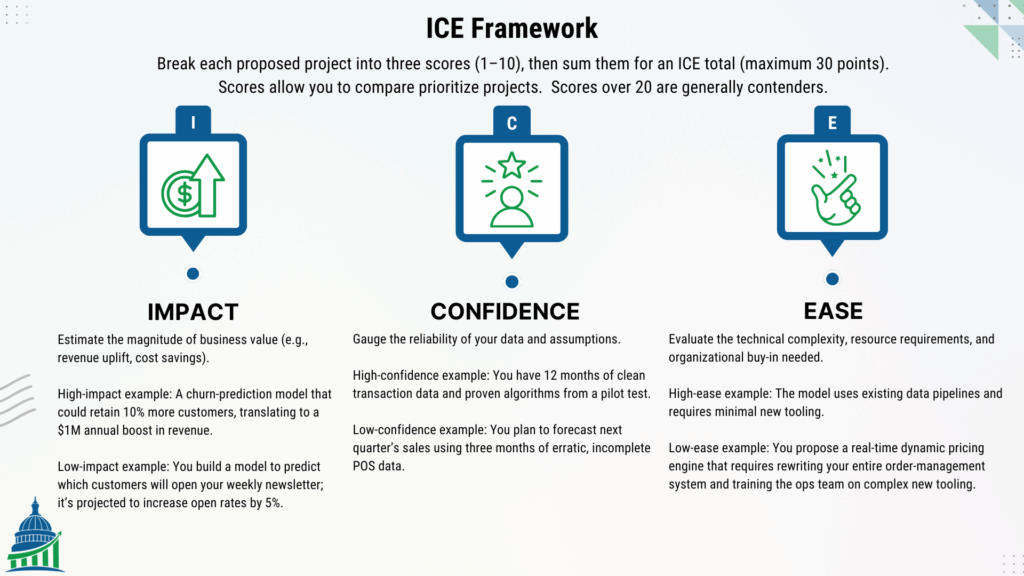
Break each proposed project into three scores (1–10), then sum them for an ICE total (maximum 30 points).
Impact: Estimate the magnitude of business value (e.g., revenue uplift, cost savings, retention improvement).
Confidence: Gauge the reliability of your data and assumptions.
Ease: Evaluate the technical complexity, resource requirements, and organizational buy-in needed.
ICE Score = Impact + Confidence + Ease
Projects scoring above 20 are typically your top contenders.
Even with a strong ICE score, every analytics project incurs “change friction”—new processes, training, and integration challenges can drag performance down by 20%. To justify the effort, target projects that promise at least a 20% return.
How to calculate:
Example: A cross-sell recommendation engine predicts a 30% increase in average order value. 30% gross uplift – 20% friction = 10% net uplift → Passes minimum ROI check.
Key Takeaway for Owners: Balance “Quick Wins” and “Moonshots”
This will ensure you get the outsized return of Moonshot projects while still delivering incremental returns on a short-term basis.
Effective predictive modeling relies on five foundational elements that transform raw data into actionable insights.
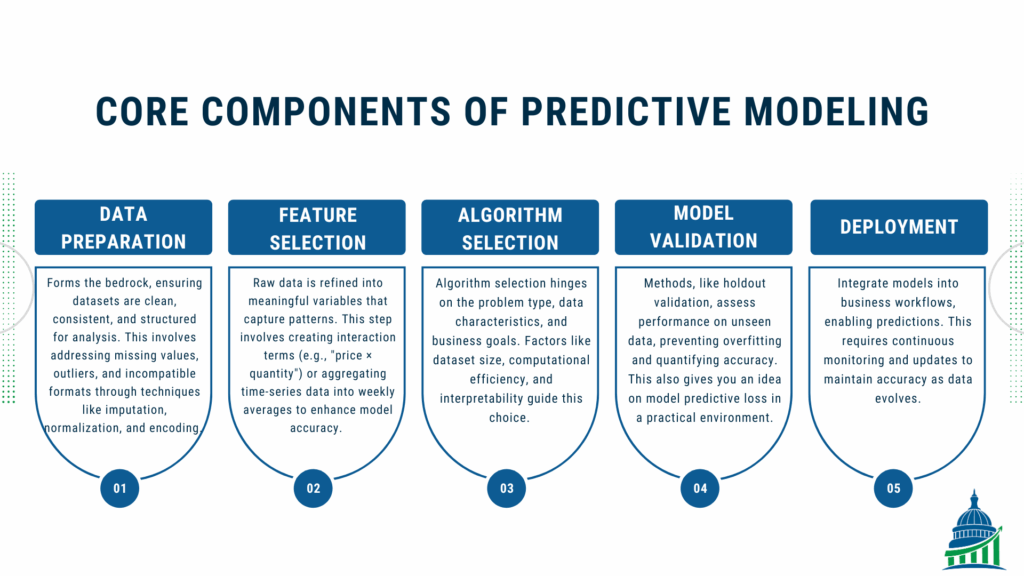
Data preparation forms the bedrock, ensuring datasets are clean, consistent, and structured for analysis. This involves addressing missing values, outliers, and incompatible formats through techniques like imputation, normalization, and encoding. For instance, categorical data such as “customer satisfaction” may require encoding to convert it into numerical formats usable by algorithms. Without proper preprocessing, even advanced models risk generating unreliable predictions.
Feature engineering follows, where raw data is refined into meaningful variables that capture patterns. This step involves creating interaction terms (e.g., “price × quantity”) or aggregating time-series data into weekly averages to enhance model accuracy. For example, a retail dataset might lack a “total revenue” column, but engineers can derive it from existing transactional data to improve demand forecasting.
Algorithm selection hinges on the problem type, data characteristics, and business goals. Regression models suit sales forecasting, while neural networks excel at detecting complex patterns in fraud detection. Factors like dataset size, computational efficiency, and interpretability guide this choice. For instance, decision trees offer transparency for regulated industries, whereas ensemble methods prioritize accuracy.
Model validation ensures reliability through techniques like cross-validation and holdout testing. These methods assess performance on unseen data, preventing overfitting and quantifying accuracy. A DTC apparel brand develops a predictive model to forecast which customers are most likely to make a repeat purchase within 60 days of their first order. To validate the model, the company splits its customer data—using 70% for training and reserving 30% as a holdout set. The model’s predictions are then tested against this unseen 30% of customer records to assess accuracy and ensure the model reliably identifies high-potential repeat buyers.
Finally, deployment integrates models into business workflows, enabling predictions. This requires continuous monitoring and updates to maintain accuracy as data evolves. For example, a deployed customer churn model might regularly weekly using fresh behavioral data to adapt to shifting trends.
Key Takeaways for Owners:
Josh owned an amazing manufacturing company producing high quality American-Made outdoor kitchens out of small-town New Hampshire. He took pride in the fact he was employing 35 people. As a matter of fact, he took it as his personal honor and duty to make sure their families were looked after while delivering an amazing product nationwide for the last 7 years.
Lead costs were soaring through the roof, Josh’s marketing team panicked and slashed budgets in expensive regions. Within weeks, the downstream effect was brutal: call lists grew thin, dial-for-dollars turned into silence, and the sales floor fell into chaos. Closing rates cratered, reps blamed the fickle economy, and Josh watched morale—and profit—disappear before his eyes.
Refusing to gamble with his team’s future, Josh demanded a smarter approach and reached out. A predictive analytics solution was able to take every data point—form answers, product pages viewed, past quote requests, even the hour of inquiry—and transform them into a single likelihood score that Josh’s team could prioritize leads by.
This allowed Josh’s marketing team to target with intentionality and grow spend in expensive regions without busting the bottom line. It also led to a sales strategy that had closers talking to leads ready to close and sales associates warming up leads that weren’t quite there yet. All this led to a 1 million dollar increase in revenue and more importantly a 20% increase in profitability.
This increase in profit allowed Josh to ensure his employees and their families were well looked after. And as a matter of fact, he was even able to expand his operations and add 4 more employees to meet all the new demand.
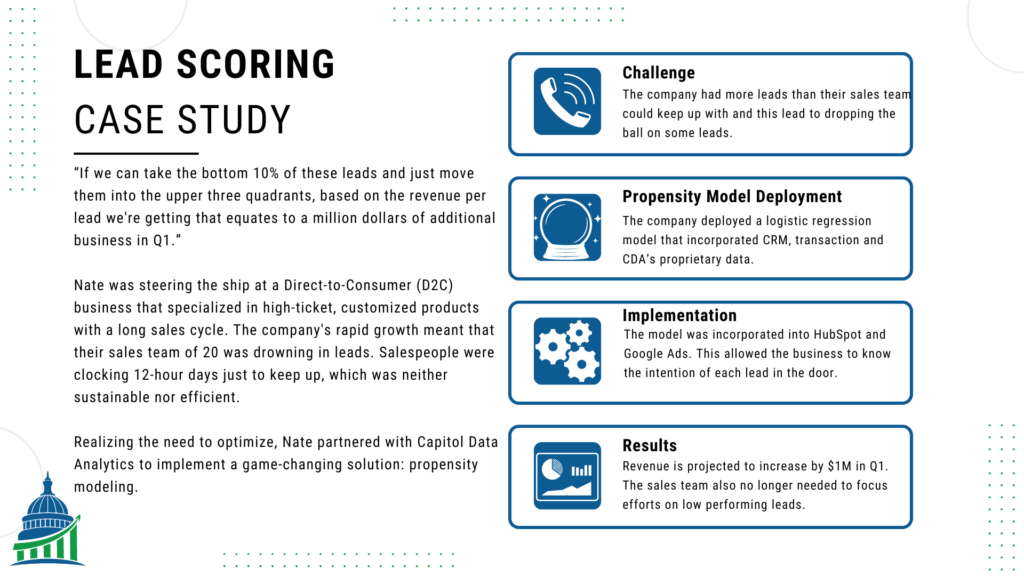
Every morning, Greg’s outbound sales team sat hunched over their headsets, day after day, making five calls to reach one customer–watching leads go to voicemail felt like opportunity was slipping away. Morale was sinking, frustration mounting: “Why aren’t our best prospects picking up?”.
As Greg stared at the flatlining contact rates, he knew It wasn’t enough to tell the team to dial harder—they needed a smarter play. So, Greg reached out to us and in that first meeting quickly realized the answer was to turn his lead data into a superpower. To do that he had to turn every nugget of CRM and transaction data such as past purchase frequency, email engagement, and even website visit timing from raw logs into predictive signals—empowering the business to call only its hottest prospects.
Armed with new lead scoring created through predictive analytics Greg’s sales team attacked the outbound calls with renewed vigor. The contact rate climbed from 20% to 30%, all by prioritizing the right leads. Calls once wasted on dead ends and frustration turned into connections and a blowout of profit in the first quarter.
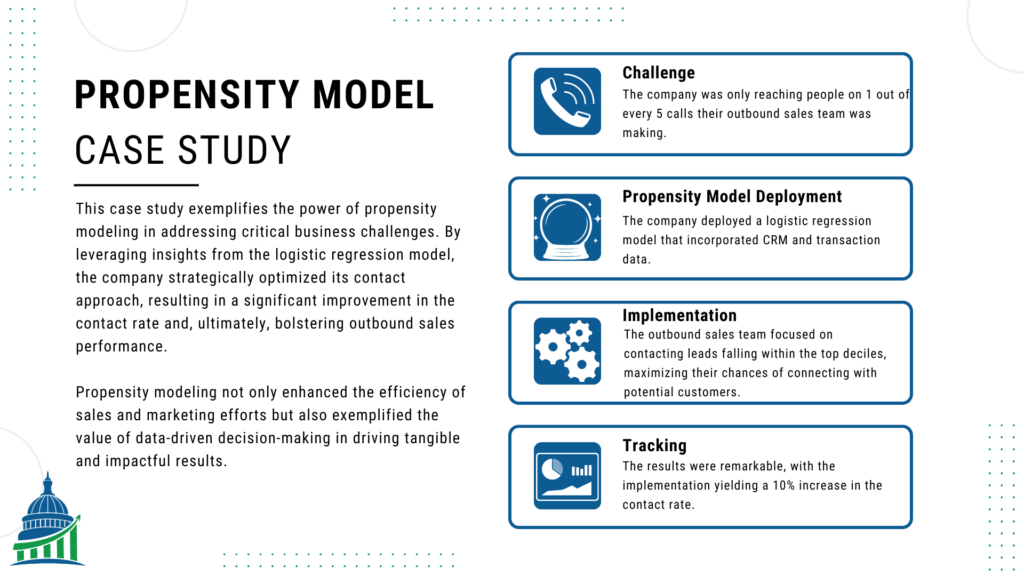
In an industry where standing still means falling behind, future-ready DTC brands are already eyeing the next evolution of predictive analytics. Gone are the days of one-size-fits-all campaigns and blanket discounts—tomorrow’s winners will harness AI not just to react, but to anticipate, personalize, and protect at scale. From hyper-personalization engines that tailor every touchpoint in real time, to privacy-first models trained on synthetic data that safeguard customer trust, these two emerging trends promise to reshape how you acquire, engage, and retain your most valuable audiences.
AI-Powered Hyper-Personalization at Scale
Problem: Generic marketing fails to engage customers in saturated markets, with 68% of shoppers abandoning carts due to irrelevant messaging.
Solution: AI-driven predictive models analyze real-time behavioral data (purchase history, browsing patterns, social sentiment) to deliver individualized product recommendations and dynamic pricing.
Impact:
Synthetic Data and Privacy-First Predictive Modeling
Problem: Stricter privacy regulations (e.g., GDPR) limit access to customer data for personalization.
Solution: AI-generated synthetic data mimics real consumer behavior without exposing personal information, training models for ethical targeting.
Impact:
Generative AI enhances predictive marketing by generating synthetic data to fill gaps and creating dynamic, personalized content. It enables scenario simulations for robust forecasting and automates hyper-targeted campaigns, boosting engagement and conversion rates.
Data preparation is foundational—cleaning, normalizing, and enriching raw data ensures model accuracy. Poor data quality accounts for the majority of project failures, making preprocessing essential.
Partially: models can auto-retrain using fresh data but require human oversight to address concept drift (e.g., shifting consumer trends). Edge AI enables real-time adjustments, yet governance ensures ethical use.
Historical data (sales, customer behavior), real-time inputs (IoT sensors), and external datasets (market trends). Structured (databases) and unstructured data (social media) are common.
Predictive analytics forecasts outcomes (e.g., sales trends), while prescriptive recommends actions (e.g., optimal inventory levels). The latter uses predictive insights to guide decision-making.
Accuracy varies by data quality and model type, with top models achieving 85–95% precision in scenarios like fraud detection. Regular validation (e.g., k-fold testing) maintains reliability.
By slashing CAC, flagging churn before it happens, accurately scoring LTV, reallocating wasted ad spend, and even unlocking cross-sell wins, you’ll convert data from rear looking narrative into a forward-looking superpower. Armed with the ICE prioritization framework and a 20%-ROI guardrail, you can confidently choose—and execute—projects that move the needle. Now it’s your turn: trade your rear-view-mirror dashboards for predictive insights, and start writing tomorrow’s success today.
If the advice from this article didn’t give you the answer you need to win the war against your competition, then click here to schedule a free call with us. We’d be honored to assist you with some customized, free guidance so you can continue to serve the communities you support so well.
Oh, and if you found this article helpful, please share it with another owner that could benefit.
Propensity models are a group of statistical models that provide immense value to your organization.
Read MoreAs an American-made manufacturer, you've relentlessly optimized your production line, yet three hidden wastage points beyond your view still threaten your profitability and even your business survival.
Read MoreBreak Open the Black Box—Unlock the Power of Sales Attribution for American-Made DTC Brands.
Read MoreNEED MORE ANSWERS ON HOW TO WIN THE WAR AGAINST CHEAP CHINESE CRAP? WE’D BE HONORED TO PROVIDE SOME CUSTOMIZED FREE GUIDANCE.